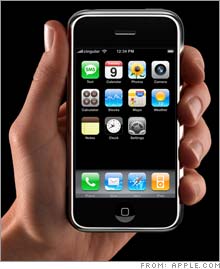Right phone, right timeForget the hype about the iPhone transforming wireless. The device arrives as consumers are primed for mobile multimedia, writes Fortune's Stephanie Mehta.(Fortune Magazine) -- The launch of Apple's iPhone is just a week away, and much of the tech world seems to agree that the device will be the greatest thing since, well, the telephone itself. "I think the iPhone may really change the whole phone industry," CEO Steve Jobs modestly predicted during a CNBC interview shortly after he announced the product. Enthused Newsweek's Steven Levy in an early review of the device: "At its best, Apple transforms a product category plagued by awkward interfaces, inadequate utility and ungainly packaging and transforms the experience into something effective and fun."  Even the dependably wry Om Malik, executive editor of GigaOm.com, jumped on the wagon, penning a June 12 post entitled "5 ways iPhone will change the wireless biz." (To Malik's credit, he pokes fun at himself in a subsequent column; after quoting AT&T CEO Randall Stephenson gushing about the device, Malik writes: "And I thought I was going ga-ga over the iPhone.") There's little question the iPhone pulls a lot of great wireless functions and applications into a very cool package. But most of those features aren't exactly new. Google Maps for mobile? Practically any smartphone user can download the application to his or her device. Apple (Charts, Fortune 500) is also touting its phone's ability to show regular websites, as opposed to the small number of websites optimized for wireless. But dozens of phones available worldwide now offer users the ability to surf the whole of the Web. Apple and its fan base will argue that the iPhone makes all these features and other applications easier to use, and they probably will be right. But I'd posit that Apple's real genius is coming into the wireless market just as consumers -- not to mention phone networks -- are finally ready to embrace a wave of wireless change. Let us count the ways: 1. American consumers are starting to shell out big bucks for phones. At $499 for 4GB of memory and $599 for 8GB, the iPhone certainly is more expensive than virtually any cellphone sold in the United States, largely because U.S. wireless carriers subsidize the cost of the handsets to encourage consumers to sign long-term service contracts. As a result, American consumers had been conditioned to think cellphones should be free. But that's starting to change. Nokia (Charts), for example, says it is seeing "strong interest" in the United States for its N95 product, which lists for a jaw-dropping $749. The big U.S. phone companies operating on the GSM standard, AT&T (Charts, Fortune 500) and T-mobile, don't presently offer the N95, so there's no carrier discount. Instead, consumers can buy the phone directly from Nokia's website and retail locations in New York and Chicago. (A user would have to separately sign up for GSM service and transfer the SIM card from the carrier-provided phone to the N95.) Nokia won't disclose exactly how many of the pricey phones they've sold, but a company spokeswoman says strong demand for the device -- which boasts many of the same features as the iPhone -- prompted Nokia to make the phone available in the United States. 2. U.S. phone networks are (sort of ) ready to deliver rich applications. A few years ago, most of the features on a device like the iPhone (or the N95, for that matter) simply wouldn't work in the United States. The wireless phone networks were too slow to handle a robust Web browser or streaming YouTube videos. And some would say, despite upgrades to wireless broadband standards, the networks are still clunky and unreliable. The iPhone, for example, will operate on AT&T's so-called EDGE network, which isn't even the carrier's latest iteration of broadband. But now there are tens of thousands of Wi-Fi hotspots that consumers can use to supplement cellular Web surfing; and these wireless local area networks really do enable the iPhone and other Wi-Fi enabled devices to deliver rich, multimedia experiences. 3. Carriers are loosening up. Apple certainly got AT&T to agree to a lot of concessions to become the exclusive U.S. wireless network supporting the iPhone. To be fair, however, some carriers are starting to rethink their stranglehold on the wireless subscriber. Instead of aggressively protecting "walled gardens," which allow subscribers access only to mobile content carriers have vetted (and been paid to promote), operators such as U.K.-based Vodafone (Charts) are slowly allowing consumers access to a greater panoply of content. Indeed, the presence of browsers such as Windows Mobile or Safari on the iPhone means carriers can no longer tightly control consumers' wireless content experiences -- nor, argues Scott Horn, general manager in Microsoft's (Charts, Fortune 500) mobile and embedded devices group, should carriers want to. Horn calls the walled garden approach "super super expensive." Carriers have to evaluate all kinds of content and figure out which products will sell (not exactly their forte). Meanwhile, carriers might be missing out on the chance to rack up some tidy revenues by charging customers extra fees for connectivity to the Web. 4. Consumers are willing to watch movies and listen to music on their cellphones. Apple gets much of the credit for proving the concept that people -- and not just teens -- will watch movies on small screens with its video-capable iPods. And though an early attempt by Motorola (Charts, Fortune 500) to add iTunes to a phone flopped, consultant Dekkers Davidson doesn't seem worried about Apple's ability to add wireless capability to a next-gen iPod. "Apple will buy the best radio technology and the best chipsets," says Davidson of consulting group Oliver Wyman. "What Apple brings is real specific capability around the user interface and user experience." |
Sponsors
|
